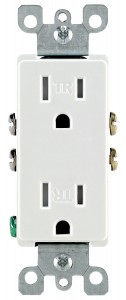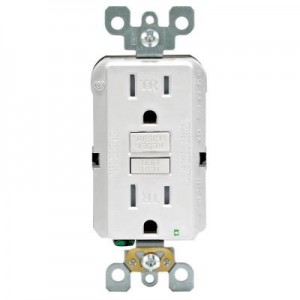Additional outlets are often needed in a variety of locations in residences. Depending on what the outlet will be used for will determine if the outlet should be dedicated from the sub-panel or if tapping it onto an existing lighting or appliance circuit would be best. When possible, we will wall fish the wires and utilize attics and basements to conceal the wiring. Occasionally, this can’t be done and holes need to be cut in the drywall; when this is the case, we will reinstall the pieces of drywall cutout, back in the wall. Other instances require the installation of wiremold or conduit to install a new or additional outlet. We have plenty of experience, both residential and commercial to make sure these wiring raceways are installed in the cleanest fashion. Also, keep in mind that the new code requires tamper resistant outlets on all general purpose outlets. If you don’t want tamper proof outlets installed and simply want the non-tamper resistant type, let us know ahead of time.
GFCI outlets are designed to protect people from electrical shock. When you look at a normal 120-volt outlet there are two vertical slots and then a round hole centered below them. The left slot is slightly larger than the right. The left slot is called “neutral,” the right slot is called “hot” and the hole below them is called “ground.” If an appliance is working properly, all electricity that the appliance uses will flow from hot to neutral. A GFCI monitors the amount of current flowing from hot to neutral. If there is any imbalance, it trips the circuit. It is able to sense a mismatch as small as 4 or 5 milliamps, and it can react as quickly as one-thirtieth of a second. So let’s say you are outside with your power drill and it is raining. You are standing on the ground, and since the drill is wet there is a path from the hot wire inside the drill through you to ground. If electricity flows from hot to ground through you, it could be fatal. The GFCI can sense the current flowing through you because not all of the current is flowing from hot to neutral as it expects — some of it is flowing through you to ground. As soon as the GFCI senses that, it trips the circuit and cuts off the electricity.
Loose or broken outlets should be replaced as soon as possible. When a plug does not fit into an outlet tightly, this can be a fire hazard and not to mention, a shock hazard. Arcing can occur which causes heat and this leads to melting of the plastic and possibly a fire.
2 prong outlets can be easily upgraded to 3 prong by installing GFCI outlets in their place. This is the simplest way, by code to convert 2 prong outlets to 3 prong. You still will not have a ground but you can plug in appliances and power strips that have ground prongs. You also will have the added shock protection that the GFCI offers if electricity comes in contact with personnel. To truly convert a 2 prong outlet to a 3 prong outlet typically requires running a ground wire from the main or sub-panel, either under the house or in the attic, and fishing this ground wire into the junction or outlet box that the outlet is mounted to, then attaching the ground wire to the green ground terminal on the outlet. This usually takes 2 to 3 hours per outlet so it can be costly. Some folks that have 2 prong outlets are fortunate and have grounded metal outlet boxes that their outlets are attached to. When this is the case, all we have to do to get a ground is simply, attach a short piece of ground wire from the metal outlet box to the ground screw on the outlet, now you have a legitimate 3 prong grounded outlet.



